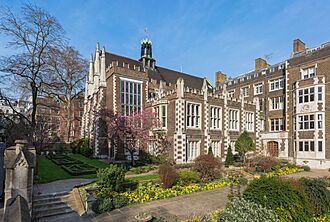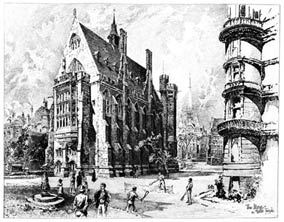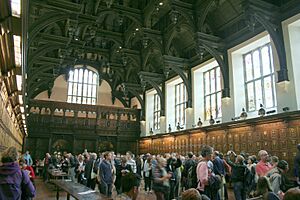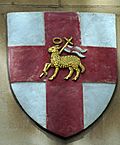Middle Temple facts for kids
Quick facts for kids The Honourable Society of the Middle Temple |
|
|---|---|

Middle Temple Hall
|
|
| General information | |
| Town or city | London |
| Country | England |
| Coordinates | 51°30′44″N 0°06′39″W / 51.51212211529157°N 0.1108662249555948°W |
The Honourable Society of the Middle Temple, often called Middle Temple, is one of four special places in London called Inns of Court. These Inns are where people train to become barristers, who are a type of lawyer in England. The other Inns are Inner Temple, Gray's Inn, and Lincoln's Inn.
Middle Temple is located in an area of London known as The Temple, close to the Royal Courts of Justice. It is also within the City of London. It acts almost like its own small, independent town, managing many of its own local services.
Contents
History
In the 1100s and early 1200s, most law was taught by church leaders in London. However, in 1218, the Pope said that church leaders could not work in regular courts. This meant that ordinary people, not priests, started to practice and teach law.
To protect their schools, King Henry II and later King Henry III made rules against teaching certain types of law in London. So, the lawyers moved to an area called Holborn. This spot was easy to reach from the law courts at Westminster Hall and was just outside the city. They formed groups, which eventually became the Inns of Court.
Middle Temple is the western part of "The Temple" area. This was once the main place for the Knights Templar, a famous group of knights, until they were disbanded in 1312. Lawyers have been in the Temple since 1320. They rented the land from the Earl of Lancaster. Later, the Temple belonged to another group of knights called the Knights Hospitaller.
In 1346, the Knights Hospitaller rented parts of the Temple to lawyers again. The eastern part became Inner Temple, and the western part became Middle Temple. The Cross of St George is still part of Middle Temple's symbol today.
Sadly, all of Middle Temple's early records were burned during the Peasants' Revolt in 1381.
After King Henry VIII took the Temple from the Knights Hospitaller in 1540, each Inn continued to rent its part from the King for £10 a year. In 1608, King James I gave the land to them permanently. They could keep it as long as they continued to teach and house lawyers and students, and look after the Temple Church. The Temple Church, built in 1185, is still a special church shared by Inner and Middle Temple.
| Records of Fines Burnt, etc. Act 1679 | |
|---|---|
| Act of Parliament | |

|
|
| Long title | An Act for reingrossing of the Records of Fines burnt or lost in the late Fire in the Temple. |
| Citation | 31 Cha. 2. c. 3 |
| Dates | |
| Royal assent | 27 May 1679 |
| Commencement | 6 March 1679 |
| Repealed | 28 July 1863 |
| Other legislation | |
| Repealed by | Statute Law Revision Act 1863 |
|
Status: Repealed
|
|
| Text of statute as originally enacted | |
In January 1679, a big fire destroyed much of Middle Temple. It caused more damage than the famous Great Fire of London in 1666. The River Thames was frozen, so people used beer from the Temple's cellars to fight the fire. They even blew up some buildings with gunpowder to stop it spreading.
The Lord Mayor of London tried to take control of the Temple during the fire, but the Temple was independent. When he couldn't, he even turned back a fire engine coming from the City. Because many important legal records were burned, a special law was passed by Parliament to fix the problem.
The first woman to join any Inn of Court was Helena Florence Normanton. She became a student member of Middle Temple on December 24, 1919. Olive Clapham, who joined on January 17, 1920, was the first woman to pass the final exams to become a barrister in May 1921.
During the Blitz (1940–1944) in World War II, the Temple was badly damaged by bombs. The Library was destroyed, much of the Church was ruined, and the main Hall was badly hit. Many of the lawyers' offices were also destroyed.
The Inns used to be like colleges for lawyers until 1852. Today, they still help train new lawyers in skills like speaking in court and understanding rules of conduct. Most of the buildings are now offices for barristers. One of Middle Temple's main jobs is to support new lawyers. They do this by offering training, scholarships (over £1 million in 2011), and affordable places to live. They also hold events where new lawyers can meet experienced ones for advice.
In 2008, Queen Elizabeth II celebrated the 400th anniversary of King James I's original grant. She issued new documents to confirm the original agreement.
Buildings
Middle Temple owns 43 buildings, many of which are historic buildings. The ones inside the Temple area are still held under the 1608 grant from King James I. Other buildings just outside the Temple were bought later. Some buildings are new, built after being destroyed in The Blitz, but others are very old, dating back to the 1500s. Middle Temple also shares responsibility with Inner Temple for Temple Church and the Master's House next to it, which was built in 1764.
The Hall
Building Middle Temple Hall started in 1562 and finished in the early 1570s. Its unique hammerbeam roof is considered one of the best in London. Queen Elizabeth I visited the hall in 1578 without warning. She wanted to see the new building and listen to lawyers debate. This was the first time a ruling monarch visited an Inn of Court.
One of the tables in the hall is said to be made from the wood of the Golden Hinde. This was the ship Sir Francis Drake used to sail around the world. Above the table is a large painting of King Charles I. There are also portraits of other kings and queens like Charles II, James II, William III, Elizabeth I, Queen Anne, and George I. The walls are decorated with shields showing the symbols of senior members, dating back to 1597.
The first known performance of Shakespeare's play Twelfth Night happened in the hall on February 2, 1602. Shakespeare himself was probably there.
The hall survived the Great Fire of London in 1666 but was damaged by bombs during World War II.
Middle Temple Hall is a very important part of the Inn. It hosts many events for members, including some that count as "qualifying sessions" for student members. These sessions help students complete their training.
The Hall is also a popular place for parties, weddings, and other events. It has become a popular spot for filming movies and TV shows. This is because of its old cobbled streets, historic buildings, and gas lighting.
Library
Not much is known about the very first library, which was probably just a room. All the books were stolen before the time of King Henry VIII. In 1625, a new library was started. In 1641, it became bigger when a member named Robert Ashley left his book collection and money to the Inn. This library was taken down in 1830.
After about 30 years, a new library was built in a Gothic style. It was opened by The Prince of Wales on October 31, 1861. This Victorian library was badly damaged during the London Blitz in 1940 and was removed after the war. A new Library was built in the 1950s and opened by the Queen Mother in 1958. This building still holds the Inn's library and records and is now called the Ashley Building.
Middle Temple Library has special old globes made by Emery Molyneux. These globes are very important for understanding old maps.
Gatehouse
The current gatehouse, on Fleet Street at the northern edge of the Inn, was built in 1684 by Sir Christopher Wren. It replaced an older one that had fallen apart. The gatehouse leads into Middle Temple Lane, which goes south through the Inn and ends at gates near the Victoria Embankment. All the buildings west of this lane belong to Middle Temple. Buildings to the east belong to either Middle Temple or Inner Temple.
Chambers
West of Middle Temple Lane
Going south from the Fleet Street gatehouse, Middle Temple Lane passes Brick Court to the west. It's called Brick Court because it's said to have the first brick buildings in the Temple, built during Queen Elizabeth I's time. Sir William Blackstone, a famous lawyer, worked here before teaching law at Oxford University. The writer Oliver Goldsmith also lived here from 1765 and is buried in Temple Church. Blackstone, who lived below Goldsmith, complained about the noise from Goldsmith's lively parties.
Next to Brick Court are buildings called Essex Court, which are part of the same area. The first mention of Essex Court is from 1640. Today, Essex Court and Brick Court are offices for barristers. A path to the west leads to New Court, built by Wren, and a gate out of the Temple.
South of New Court and Essex Court is Fountain Court. The fountain there was described by Charles Dickens in his book Martin Chuzzlewit. South of Fountain Court are Garden Court (where the old library was), Middle Temple Gardens (which go to the southern edge of the Temple), and Middle Temple Hall. The current buildings of Garden Court were built in 1883. South of Garden Court are Blackstone House, Queen Elizabeth Building, and a gate leading out of the Temple, close to Temple tube station.
South of the hall, and east of the gardens, are Plowden Buildings, built in 1831. These contain the Treasurer's office. South of that is the current library. At the end of Middle Temple Lane are the Temple Gardens buildings, built by both Inns in 1861. The western part belongs to Middle Temple, and the eastern part to Inner Temple. The lane goes through the middle of Temple Gardens through an archway and leads out of the Temple.
East of the lane
Along the east side of Middle Temple Lane, the buildings belong to Inner Temple until you reach Lamb Buildings. Lamb Buildings belong to Middle Temple. Middle Temple bought this land from Inner Temple after the Great Fire of 1666 because Inner Temple needed money after so much damage. Lamb Buildings are built where Caesar's Buildings used to be, which were destroyed in the fire and belonged to Inner Temple. The Lamb of God is Middle Temple's symbol and is carved above the entrances to the building.
Behind Lamb Buildings, further east, is Elm Court, built in 1880. The buildings on the south and east sides of Elm Court are part of Inner Temple. The west and north buildings are Middle Temple. Further north is Pump Court, one of the oldest areas in the Temple. Most of the buildings here belong to Middle Temple, except those in the north-west corner. Further east are Middle Temple's cloisters, which lead to Church Court between Temple Church and Inner Temple Hall. North of Pump Court is Inner Temple's Hare Court, and then more buildings belonging to Middle Temple, until the lane ends at the gate to Fleet Street.
Parallel to and east of Middle Temple Lane is Inner Temple Lane. On the east side of Inner Temple Lane, and across from Hare Court, is Goldsmith Building. It's named because it's close to Oliver Goldsmith's tomb in Temple Church. Even though it's in Inner Temple, Goldsmith Building actually belongs to Middle Temple. It was built in 1861.
Structure and governance
The Inn's main governing body is its Parliament. This group is made up of Benchers, who are judges and senior barristers chosen for life. The Parliament is led by the Treasurer, who is chosen every year. Parliament approves the Inn's budget and allows qualified student members to become barristers. Members of the British royal family who are made honorary benchers are called "Royal Benchers." The first was The Prince of Wales (who later became King Edward VII) in 1861.
The Inn is managed day-to-day by an Executive Committee and five other committees. These committees report to the Parliament. The Executive Committee has nine voting members, including the Treasurer.
The Treasurer for 2025 is Lady Justice Kathryn Thirlwall. The Chief Executive and Under Treasurer is Christopher Ghika.
Liberty
Middle Temple (like Inner Temple) is one of the few remaining "liberties". This is an old name for a special area. It is an independent area that historically was not governed by the City of London Corporation. It also was not under the church control of the Bishop of London. Today, Middle Temple acts like a local council for most things.
Even though it's independent, it is still geographically inside the City of London.
Some of the Inn's buildings are just outside the Middle Temple's special area and the City's boundary. These buildings are actually in the City of Westminster. Quadrant House (7–15 Fleet Street) was bought by Middle Temple in 1999. After five years of changes, it is now offices for barristers. This building is outside the liberty but still within the City of London.
Badge and coat of arms
Middle Temple's badge shows the Lamb of God holding a flag with the Saint George's Cross. This symbol is in the middle of the Inn's coat of arms, which has a red cross on a white background. Both the cross and the lamb with the flag were symbols of the Knights Templar.
Qualifying sessions
Students who are members of the Inn must attend at least 10 "qualifying sessions." Six of these must be in person, either at the Inn or in other cities. Qualifying sessions used to be called "dinners." They combine social and learning activities. They usually include a dinner or reception with talks, debates, practice court sessions, or music. These often happen in The Hall.
Notable members
- Sir Edmund Plowden, English lawyer
- William Byrd II, American lawyer and author
- Sir John Popham, a top judge in England
- Sir Walter Raleigh, English statesman and author
- Arthur Onslow, English politician
- John Evelyn, English writer
- Sir William Blackstone, English legal expert
- Charles Dickens, English writer
- Thomas Morris Chester, American lawyer and soldier
- Vallabhbhai Patel, Indian statesman and barrister
- Qazi Muhammad Isa, Pakistani statesman and barrister
- Chittaranjan Das, Indian lawyer
- Birendranath Sasmal, Indian independence activist and barrister
- Geoffrey Howe, British politician
- Ratu Sir Lala Sukuna, Fijian statesman and soldier
- John Rutledge, Chief Justice of the US Supreme Court and Governor of South Carolina
Royal benchers
- The Prince of Wales (later Edward VII) (1861; served as Treasurer in 1866)
- Prince Albert Victor, Duke of Clarence and Avondale (1885)
- The Prince of Wales (later Edward VIII) (1919)
- Queen Elizabeth The Queen Mother (1944)
- Diana, Princess of Wales (1988)
- William, Prince of Wales (2009)
Other honorary benchers
- William Howard Taft (1922), US chief justice and president
- Anthony Eden (1952), prime minister
- Harold Macmillan (1958), prime minister
- Warren E. Burger (1971), US chief justice
- Lord Denning (1972), a senior judge
- Sadiq Khan (2019), Mayor of London
See also
 In Spanish: Middle Temple para niños
In Spanish: Middle Temple para niños
- List of members of Middle Temple






